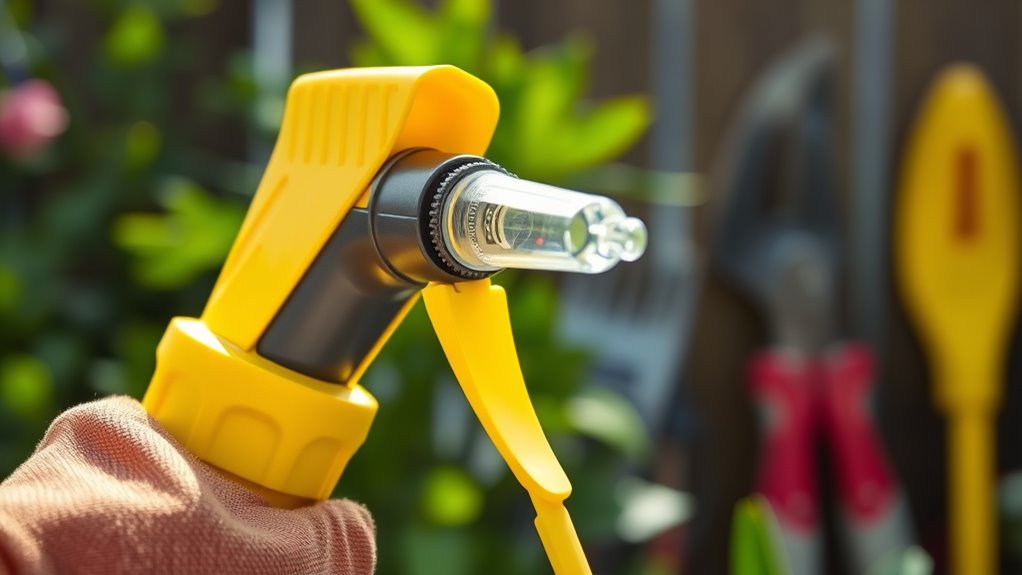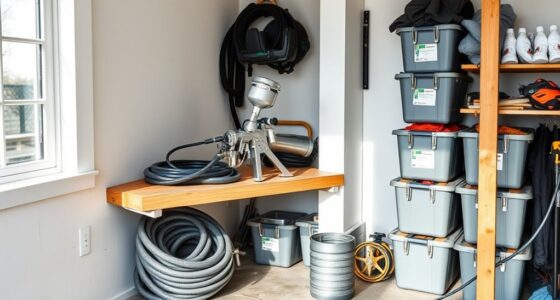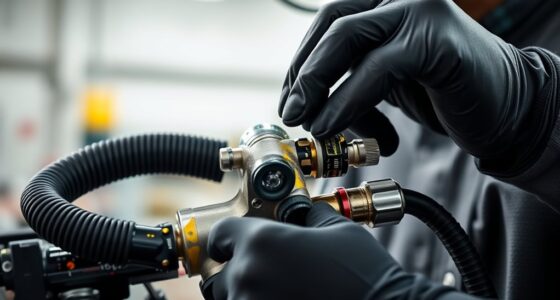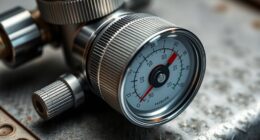If your sprayer won’t prime, start by checking for air leaks around fittings, hoses, and seals, tightening or replacing any that are damaged. Confirm the fluid level is adequate and clear any clogs or debris inside hoses and valves. Bleed trapped air by tilting or shaking the system, and verify that the pump or motor is working properly. Regular maintenance can prevent these issues, so keep an eye on system components to avoid recurring priming problems.
Key Takeaways
- Check for air leaks or loose fittings that may prevent proper priming.
- Ensure hoses are free of kinks, blockages, or debris that hinder flow.
- Confirm the pump is functioning correctly and the system is free of trapped air.
- Verify that the fluid level is adequate and the inlet screen is clear.
- Inspect and replace worn seals, valves, or damaged components to maintain proper system sealing.
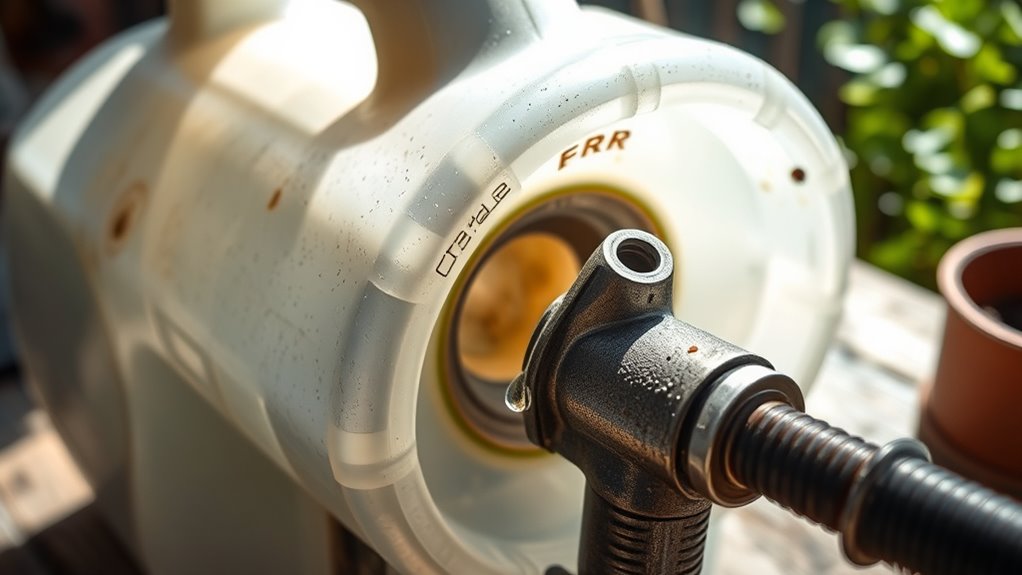
If your sprayer won’t prime, it can be frustrating and hinder your work. You might find yourself wasting time trying to figure out why the fluid isn’t reaching the nozzle. The first step is to check your hose maintenance. Over time, hoses can develop clogs, leaks, or blockages that prevent proper suction. Inspect the hose thoroughly for any cracks, holes, or kinks that could restrict flow. Make sure the hose connections are tight and secure. Sometimes, debris or buildup inside the hose can cause a partial or complete blockage, so it’s wise to disconnect it and flush it out with clean water or a cleaning solution suitable for your sprayer type. Regular hose maintenance helps prevent these issues from recurring and ensures consistent performance.
Next, focus on pump troubleshooting. The pump is responsible for creating the suction needed to draw fluid from the tank and push it through the system. If the pump isn’t functioning properly, priming issues will occur. Check the pump for any signs of damage or wear. Confirm that it’s receiving power if it’s electrically operated, or that the mechanical parts are moving freely if it’s a manual or hydraulic pump. If the pump has a pressure relief valve, ensure it’s closed and functioning correctly. Sometimes, air can get trapped inside the pump or lines, causing it to lose prime. To fix this, you might need to bleed the system by opening a vent or fitting to release trapped air. Also, verify that the fluid level in the tank is sufficient and that the intake screen isn’t clogged, which can prevent fluid from entering the pump.
If you’ve inspected the hose and the pump and still can’t get your sprayer to prime, consider checking the inlet and outlet valves. Faulty or stuck valves can block fluid flow, preventing priming altogether. Clean or replace them if necessary. Additionally, make sure the system isn’t air-bound; sometimes, tilting or shaking the sprayer can help dislodge air pockets that are preventing proper flow. Always ensure that all fittings are tight and sealed, as leaks can introduce air into the system and compromise priming. Regular maintenance, such as replacing worn seals and inspecting hoses, reduces the likelihood of priming problems in the future. Properly maintaining your appliance components and system can help prevent these issues and keep your sprayer working efficiently.
Frequently Asked Questions
How Often Should I Prime My Sprayer?
You should prime your sprayer whenever you notice uneven spray or if it hasn’t been used for a while, to guarantee proper primer maintenance. Regular priming also helps with sprayer calibration, so you get accurate application rates. Don’t forget to check your primer for clogs or air leaks before each use. Consistent priming maintains ideal performance, prevents clogging, and keeps your sprayer functioning smoothly.
Can Cold Weather Affect Sprayer Priming?
Cold weather can definitely impact sprayer priming because cold temperatures affect the fluid’s viscosity and can cause parts to freeze or become less responsive. Weather impact is significant; when it’s chilly, your sprayer might struggle to create the necessary vacuum, leading to difficulty in priming. To prevent this, store your sprayer in a warm place and check for ice or blockages before use in cold conditions.
Is It Safe to Use Alternative Liquids for Priming?
Like a modern-day alchemist, you might wonder if using alternative liquids for priming is safe. Usually, it’s not recommended because these liquids can damage your sprayer or clog the system. Always consider safety considerations first—stick to the manufacturer’s recommended priming fluids. If you must use alternatives, make sure they’re compatible and won’t cause corrosion or leaks. When in doubt, consult your sprayer’s manual or a professional.
What Signs Indicate a Damaged Sealing Gasket?
If you notice leaks around the gasket or the sprayer loses pressure quickly, it’s a sign of seal damage or gasket failure. Cracks, brittleness, or deformation in the gasket indicate it’s compromised. You might also see fluid seeping from the seal area or inconsistent spray patterns. These signs mean you should replace the gasket promptly to prevent further damage and make certain your sprayer functions properly.
How Do I Prevent Future Priming Issues?
To prevent future priming issues, follow regular maintenance tips like checking seals, hoses, and filters for wear or damage. Always make certain the tank is filled properly and that all connections are tight before use. Troubleshooting steps include inspecting for leaks, clearing blockages, and confirming the spray nozzle isn’t clogged. Consistent maintenance helps your sprayer operate smoothly and minimizes priming problems over time.
Conclusion
If your sprayer still won’t prime after troubleshooting, don’t give up. Regular maintenance can prevent many priming issues, saving you time and frustration. Did you know that improperly maintained sprayers can waste up to 30% of your chemicals? Staying proactive guarantees your equipment works efficiently and lasts longer. So, take these steps seriously, keep your sprayer clean, and you’ll be ready to tackle any project without delays or headaches.
